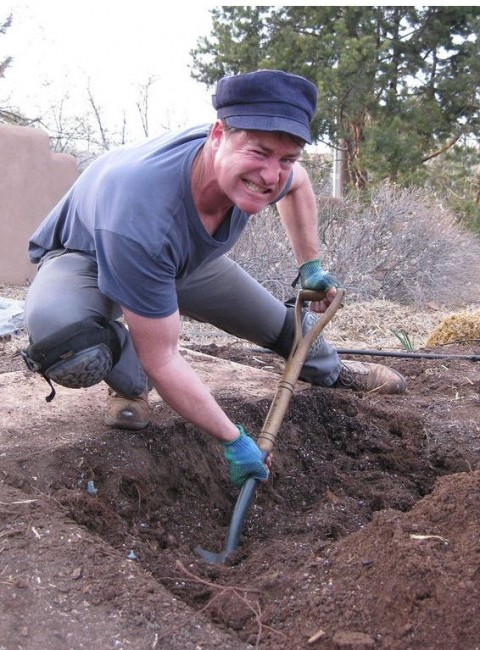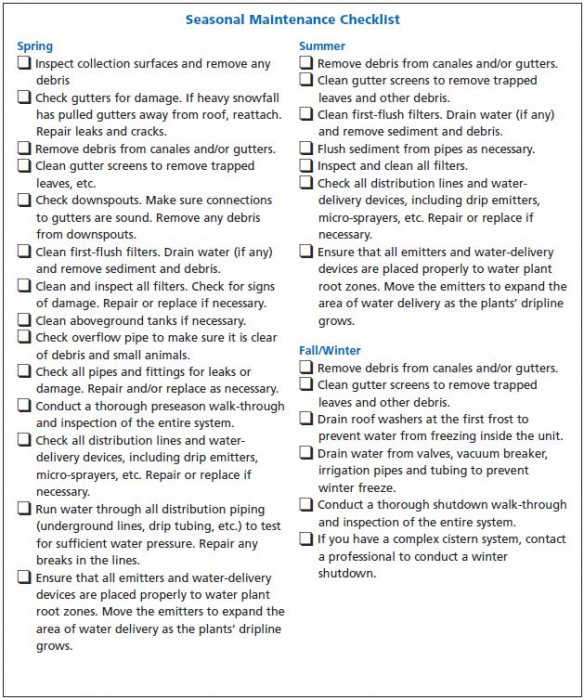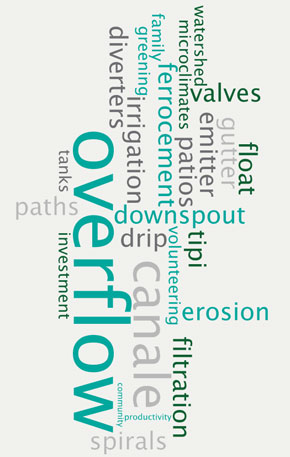The PermaDesign Weblog, with Nate Downey and Melissa McDonald!
The Soil Likes Compost, and Sweat
This month's *Permaculture in Practice* features body intensive, biodynamic, and biointensive gardening practices--and also announces a big upcoming Biodynamics Association conference in Santa Fe this November.
03/14/2016 | (0) Comments
Roof-Reliant Landscaping™ Step 21: Glossary
Air vent—a screened opening above the elevation of a water tank’s supply point designed to prevent an implosion caused when a large quantity of water is rapidly removed from the tank.
As-built—documentation that shows how every part of a cistern system fits together. Ideally, this documentation would have photographs and illustrations of all of the system components and a written narrative that describes each piece of the system, how it works and how it fits together as a whole.
Auxiliary supply—an alternative to harvested rainwater for watering landscape plants. Typically, this water would come from a well or from a municipal water system. An auxiliary supply is not recommended by the New Mexico Office of the State Engineer.
Berm—a bank of earth formed to direct the flow and/or collect rainwater. A berm placed on the downhill side of a plant is an effective way to passively harvest stormwater and encourage the water to slowly percolate into the soil.
Caliche—a zone of virtually impenetrable calcium carbonate or other carbonates in soils of semiarid regions (such as New Mexico). A layer of caliche can sometimes be as difficult to dig through as concrete.
Canale—a short, narrow trough that protrudes through the parapet of a flat roof and directs water onto the ground below. Collection surface (Catchment surface)—the surface from which rainwater is captured, usually a roof.
Check dam—a low barrier placed perpendicular to the flow of water within a drainage area (such as a small natural ditch or arroyo) designed to slow the flow of water to prevent erosion and encourage water infiltration. A check dam should be low enough to allow water to spill over it during significant storm events. Check valve—a mechanical device which allows fluid to flow through it in only one direction. Check valves work automatically and most are not controlled by a person or any external control.
Cistern—a storage tank for collected precipitation. Cisterns can be aboveground, partially buried or completely buried below ground. As used in this manual, cistern system also refers to an entire roof-reliant landscape irrigation system.
Compost—a soil amendment made from organic matter (leaves, grass clippings, vegetable scraps, etc.) that has been decomposed. Compost is an important ingredient of healthy soil.
Conveyance system—the conveyance system channels water from collection surface areas tostorage tanks. These systems can include gutters, downspouts, pipes and other components.
Daylight pipe—an overflow pipe from a cistern with an outlet into the open air. A daylight pipe distributes overflow water from the cistern to the “daylight point” at ground level in the landscape, preferably near plants.
Delivery point (Supply point)—the point where conveyed water reaches a cistern for storage. The delivery point is the last step in the rainwater conveyance process.
Distribution system—the distribution system delivers water from the storage tank(s) to the landscape. This system can be as simple as a valve and a hose or can include pipes, a pressure tank, drip tubing, drip emitters and other components.
Downspout—a pipe for conveying rain water from a roof or gutter toward a cistern. Downspouts efficiently convey water along a vertical drop, typically from a pitched roof.
Drain box (Catch basin)—a collection box for water, typically located underneath a canale. Water collected by the drain box flows
03/11/2016 | (0) Comments
Roof-Reliant Landscaping™ Step 20: Checklist
Above: A Checklist for Seasonal Maintenance
03/09/2016 | (0) Comments
Roof-Reliant Landscaping™ Step 19: Maintenance
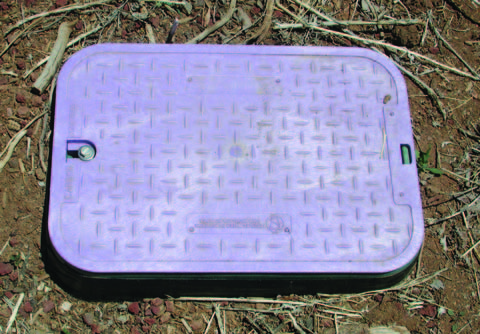
Above: This purple valve box cover indicates the water in this system is nonpotable.
After the design, installation and successful use of a rainwater harvesting system, the roofreliant landscaper’s work is not over. In order to keep a cistern system functioning efficiently, routine inspection and maintenance are required on a regular basis.
03/07/2016 | (0) Comments
El Lobo
It appears that the State of New Mexico thinks it must now give permission to US citizens who wish to release wolves in Mexico--and not just across the border--Rancho La Mesa Parque Ecologico is located SOUTH of Mexico City! #legalgymnastics! (Please also see my related blog, "Bring Back the Wolf," http://www.santafenewmexican.com/news/local_news/ladder-ranch-wolf-program-resumes-with-state-s-ok/article_5c054e14-68b1-50dc-8aea-15de6e18ada4.html
03/05/2016 | (0) Comments
Ecocide
I'm not sure how "extensive destruction, damage, or loss" would be defined or how this international law would be enforced, but I do think using the word "ecocide" is a good idea. We need to describe the clear connection between ecocide and its reciprocal attack against peace among peoples of the world. https://www.positive.news/2011/society/justice/5722/ecocide-law-%E2%80%98game-changer%E2%80%99-environment/
03/04/2016 | (0) Comments
Roof-Reliant Landscaping™ Step 18E: Water Distribution - Low-Cost Distribution Alternatives
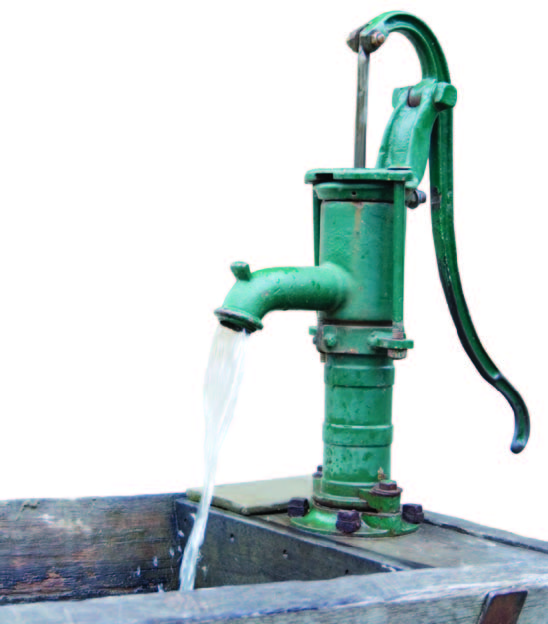
Above: A hand pump is an old-fashioned device that requires no electricity to operate—just human muscle power.
Low-Cost Distribution Alternatives
The vast majority of roof-reliant landscape designers will choose an electric pump to move water from the cistern to the distribution system. However, if the budget for your roof-reliant landscaping system is tight, here are two low-cost distribution alternatives that you may want to consider:
03/04/2016 | (0) Comments
Roof-Reliant Landscaping™ Step 18D: Water Distribution - Hose watering
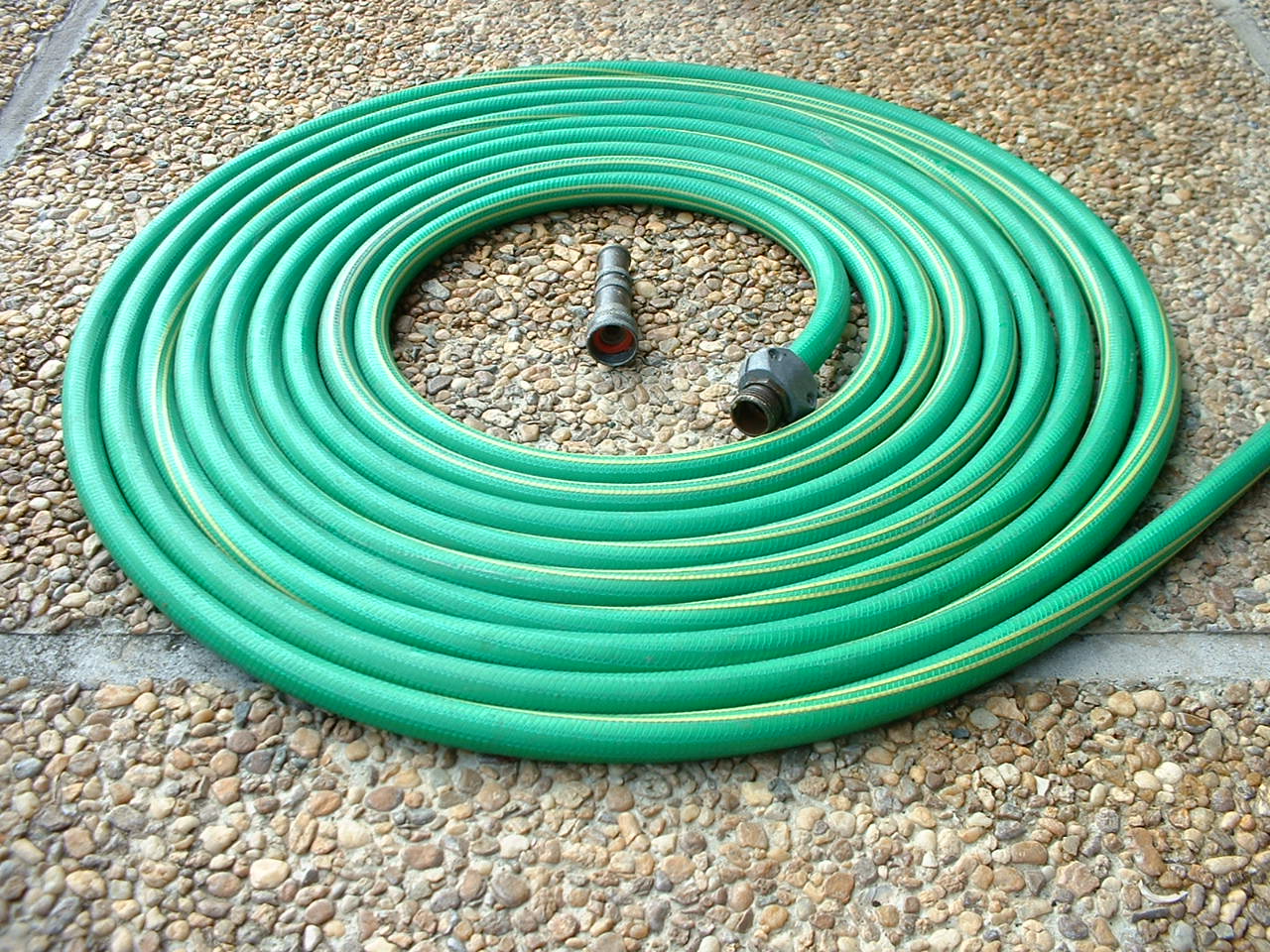
By Nandhp - Own work; Self-published work by Nandhp, CC BY-SA 3.0, https://commons.wikimedia.org/w/index.php?curid=691443
Hose watering
On the other side of the distribution spectrum is conventional hose watering, which requires nothing more than an ON/OFF valve, a frost-free hydrant connected to a pump and someone willing to move a hose. A nozzle should be added to control the flow rate of water through the hose.
If you are considering watering with a hose, make sure you check your landscape design for ways that make this chore easier. Especially on steep sites, you can reduce watering time and effort by grouping your plants so that several can be watered efficiently with each hose placement. This can be accomplished by properly grading densely planted garden beds and also by placing the most water-thirsty plants closest to your spigot locations. With grading that effectively uses gravity, a hose watering system can leave much of the work to nature. Even if you are very committed to using drip irrigation, it is beneficial to also install a frost-free hydrant for spot watering with a hose.
Advantages and Disadvantages of Hose Watering
The best part about a hose watering system is the low cost of installation. There are no multiple valves, tubing, emitters, stakes or any other components of drip irrigation. There are also no trenches to dig and no water lines to cover up with mulch or soil. Hose watering includes, quite simply, a hydrant or valve at the point of hydraulic lift, a hose and a spray nozzle.
The most difficult part of hose watering is that the watering needs to be done regularly, carefully and consistently until your plants are wellestablished. Many people simply do not have the time for hose watering by hand, so they often decide to spend the extra money for drip irrigation with its inherent precision and automation.
03/03/2016 | (0) Comments
Roof-Reliant Landscaping™ Step 18C: Water Distribution - Drip Irrigation
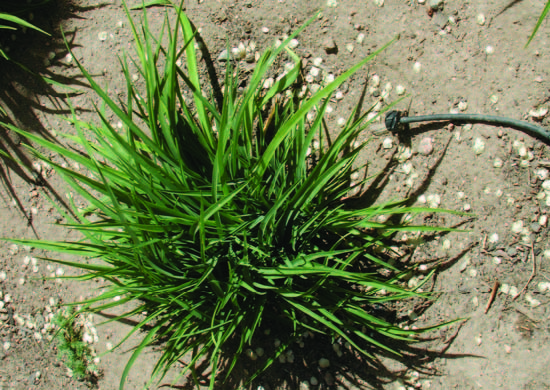
Above: Drip emitters deliver water to plant root zones with very little waste.
Drip Irrigation
Drip irrigation (commonly known as “drip”) directs water right to where plants need it—at their root zones. Using a network of poly-propylene tubing, drip irrigation releases a slow trickle of water through properly placed emitters. As long as this type of irrigation system is properly installed, closely monitored and efficiently maintained, drip is a highly efficient water-delivery method. Drip emitters are often located under mulch, so, with a drip system, very little water is lost due to evaporation. In most cases, drip irrigation is the preferred form of landscape irrigation in New Mexico.
03/01/2016 | (0) Comments
Roof-Reliant Landscaping™ Step 18B: Water Distribution - Inline Pump
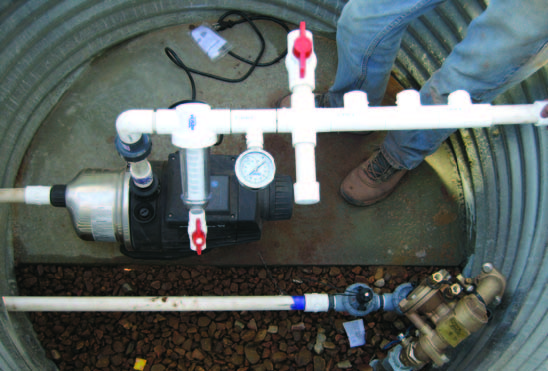
Above: Sample inline pumphouse with spin filter manifold
Inline Pumps
At minimum, inline pump systems require an inline pump and a pump house. The pump house protects the pump from the elements as well as
from vandals and/or thieves. Pump houses are typically located underground (Figure above), but they can also be constructed aboveground in a separate structure.
02/29/2016 | (0) Comments
